As an Amazon Associate I earn from qualifying purchases. By using these particular links there is no increase in cost to you as the purchaser.

 Note: The Lost Mary: Rediscovering the Mother of Jesus (Knopf, 2025) will be released on September 30, 2025. Available now for pre-orders. If you do preorder send an email stating this to genesis2000press@gmail.com and we will send you a 33 page sample including Chapter One with notes.
Note: The Lost Mary: Rediscovering the Mother of Jesus (Knopf, 2025) will be released on September 30, 2025. Available now for pre-orders. If you do preorder send an email stating this to genesis2000press@gmail.com and we will send you a 33 page sample including Chapter One with notes.
NEW! Just Published

Restoring Abrahamic Faith (Charlotte: Genesis 2000 Press, 2025).Revised and Expanded 4th Edition available now in Paperback and Kindle.
Reader Response: Thank you again for the copy of latest revised and expanded edition of your book, Restoring Abrahamic Faith. I liked the previous edition but now am I am reading this one. It is in my opinion your very best work! How can I get additional copies to share with my friends? This book needs to be widely read. I’d love to see it on the NYT best seller list!
Restoring Abrahamic Faith attempts to set forth in a clear and engaging style an exposition of the ancient Hebrew Faith as broadly represented in the Hebrew Bible, with a particular emphasis on Abraham, Moses, the Torah, and the Prophets. It offers a compelling proposal for the 21st century, namely a return to the “ancient paths” of the Hebrew faith with Abraham, the first Hebrew, as a prime model. As such it is foundational to the origins of Judaism, Christianity, and Islam, the three great Abrahamic Faiths that subsequently developed in different directions. Abrahamic Faith takes one back to the beginnings, and thereby offers a perspective that is as fascinating as it is valuable for anyone interested in the biblical tradition. This Fourth Edition has been carefully revised and expanded and is geared to non-specialist readers-written for those of any faith or no faith, but especially those who are drawn to understanding the historical Jesus and his original Hebraic message in its ancient biblical contexts.
REVIEWS
This terrific little book is a “must read.” We love this book because it takes the Bible completely seriously, explores it fearlessly, following the text itself, and other sources, and explains things—including, e.g., the na-ture and early history of Christianity, but also many aspects of the Torah Tradition itself—directly, simply, and rigorously honestly.
Michael Dallen, 1st Covenant Foundation
You’ve produced a superb manifesto in this book, very similar in many ways to my own personal credo. It is truly a wonderful, inspirational book that should draw people back to the fundamental biblical message, one which puts Jesus, James and John the Baptizer into context.
Prof. Barrie Wilson, York University, Toronto
I just finished reading an amazing book, Restoring Abrahamic Faith. Tabor’s book is a manifesto of biblical theology deeply rooted in the text of the Hebrew Bible (Old Testament). The book is full of profound wisdom and penetrating observations that skillfully elucidate the meaning of numerous biblical verses.
Nehemiah Gordon, Ph.D. Biblical Scholar, Author
I have just finished Restoring Abrahamic Faith. I’m not sure that my words will convey how profoundly your book has reached me. You have put into words something that I have “felt” and understood but didn’t have words or ways to convey what I felt and under-stood. . . A new pathway has opened for me through your words and I can’t wait to see where it takes me.
Lori Bollinger, Trinity Episcopal Church Boston
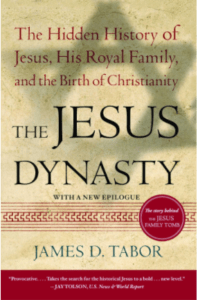
The Jesus Dynasty: A New Historical Investigation of Jesus, His Royal Family, and the Birth of Christianity (New York: Simon & Schuster, April 2006. Published in twenty languages. (Kindle and Audio links)
New York Times Best Seller, Major media coverage including cover of USNews&WorldReport, ABC-TV Good Morning America, 20/20, Nightline. National and international book tour; Extensive media coverage and reviews.
The Jesus Dynasty offers a startling new interpretation of the life of Jesus and the origins of Christianity that is grounded in careful analysis of the earliest Christian documents and recent archaeological discoveries, including the much-discussed “Jesus family tomb.”
In The Jesus Dynasty, biblical scholar James Tabor brings us closer than ever to the historical Jesus. He explains the crucial relationship between Jesus, a royal descendant of David, and his relative John the Baptizer, a priestly descendant of Aaron and Jesus’ teacher. When John was killed, several of his followers — including Jesus’ four brothers — joined with Jesus, who continued John’s mission, preaching the same apocalyptic message. After Jesus confronted the Roman authorities in Jerusalem and was crucified, his brother James succeeded him as the leader of the Jesus dynasty.
James Tabor has studied the earliest surviving documents of Christianity for more than thirty years and has participated in important archaeological excavations in Israel. His reconstruction of the life of Jesus and his followers, and of the early years of Christianity, will change our understanding of one of the most crucial moments in history.
“Many scholars have undertaken studies of Jesus and his legacy; none has dared advance the boldly provocative theses of The Jesus Dynasty.” — Bart Ehrman, author of Misquoting Jesus
“Provocative. . . . Takes the search for the historical Jesus to a bold . . . new level.” — Jay Tolson, U.S. News & World Report
“James Tabor stands out among his generation of biblical scholars for his thorough familiarity with the full range of textual evidence from the first centuries, his extensive experience with archaeological excavations, and his imagination and creativity. Tabor has a remarkable ability to discern the contours of vital religious movements from the scattered bits and pieces of evidence that survive from antiquity. Anyone who takes the career of Jesus seriously will have to reckon with his bold, new synthesis.”
— Professor Eugene V. Gallagher, Rosemary Park Professor of Religious Studies, Connecticut College
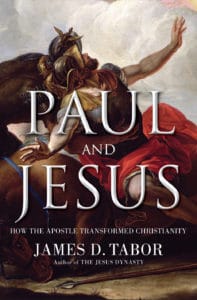
Paul and Jesus: How Paul Transformed the Gospel of Jesus. (New York: Simon & Schuster, 2012) (Kindle and Audio links)
In this “compulsively readable exploration of the tangled world of Christian origins” (Publishers Weekly), religious historian James Tabor illuminates the earliest years of Jesus’ teachings before Paul shaped them into the religion we know today.
This fascinating examination of the earliest years of Christianity reveals how the man we call St. Paul shaped Christianity as we know it today.
Historians know almost nothing about the two decades following the crucifixion of Jesus, when his followers regrouped and began to spread his message. During this time Paul joined the movement and began to preach to the gentiles. Using the oldest Christian documents that we have—the letters of Paul—as well as other early Christian sources, historian and scholar James Tabor reconstructs the origins of Christianity. Tabor shows how Paul separated himself from Peter and James to introduce his own version of Christianity, which would continue to develop independently of the message that Jesus, James, and Peter preached.
Paul and Jesus illuminates the fascinating period of history when Christianity was born out of Judaism.
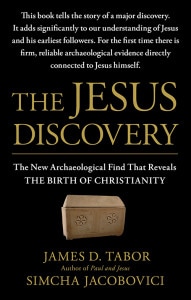 The Jesus Discovery: The New Archaeological Find That Reveals the Birth of Christianity, with Simcha Jacobovici. (New York: Simon & Schuster, 2012) (Kindle and Audio links)
The Jesus Discovery: The New Archaeological Find That Reveals the Birth of Christianity, with Simcha Jacobovici. (New York: Simon & Schuster, 2012) (Kindle and Audio links)
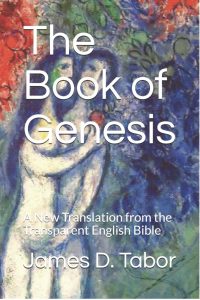 The Book of Genesis: A New Translation from the Transparent English Version (Charlotte, NC: Genesis2000, 2020). (Hardcover and Kindle links)
The Book of Genesis: A New Translation from the Transparent English Version (Charlotte, NC: Genesis2000, 2020). (Hardcover and Kindle links)
There’s an ancient, mysterious quality about it that makes me want to like Moses take my shoes off while standing on holy ground. Professor James D. Langford, Ph.D. Linguistics, University of Texas
The first book of the Bible presented in an authentic translation that allows the English reader to “peer through” to the Hebrew and “come as close as we will probably ever come to the original text.” This translation allows readers to experience the original Hebrew and the rich resonance of alliteration, pun, word play, and idiom that are so essential to the meaning of the Bible itself. These elements of the text are more than merely stylistic; they allow the reader to understand the echoes and meaning of the text in a way never before available. Beyond the content, the flow and verbal rhythm of the original Hebrew is conveyed, not through English style but through a reflection of its basic structure. This translation allows readers to experience the original Hebrew and the rich resonance of alliteration, pun, word play, and idiom that are so essential to the meaning of the Bible itself. These elements of the text are more than merely stylistic; they allow the reader to understand the echoes and meaning of the text in a way never before available. Beyond the content, the flow and verbal rhythm of the original Hebrew is conveyed, not through English style but through a reflection of its basic structure.This translation allows readers to experience the original Hebrew and the rich resonance of alliteration, pun, word play, and idiom that are so essential to the meaning of the Bible itself.
Praise for the Book of Genesis:
It also brings the reader closer to the spirit and sense of the original sources than any other translation I have seen. Professor Richard Rubenstein, Philosophy and Religion, George Mason University
As close as we will probably ever come to the original text. Professor Eugene Gallagher, Religious Studies, Connecticut College
There’s an ancient, mysterious quality about it that makes me want to like Moses take my shoes off while standing on holy ground. Professor James D. Langford, Ph.D. Linguistics, University of Texas
 Paul’s Ascent to Paradise: The Apostolic Message and Mission of Paul in the Light of his Mystical Experiences (Charlotte, NC: Genesis2000, 2020). (Hardcover and Kindle links)
Paul’s Ascent to Paradise: The Apostolic Message and Mission of Paul in the Light of his Mystical Experiences (Charlotte, NC: Genesis2000, 2020). (Hardcover and Kindle links)
Paul makes the singular claim to have been the “last but not the least” of the Apostles of Jesus. Paul never met Jesus, but he makes high claims for his experiences of mystical revelations that include his ascent to heaven and his claim to not only have “seen” Jesus in his glory, but to have regularly communicated with the one he calls the Risen Christ. Early Christianity, as it unfolds, stands or falls on the claims of this single man whose Message and Mission are distinct from that of James, Peter, and John. In this book Paul’s Ascent to Paradise becomes an entrée into his whole world of Hellenistic mystical religious experience. This “history of religions” approach to Paul supersedes the dogmatic approaches of Christian theology and dogma. It is refreshing, gripping, dramatic, bold and fascinating. For Paul the “appointed time of the end had grown very short,” to use his words. Everything has to be viewed through that apocalyptic lens and one is transported back to Paul’s social world, the “battles of the apostles,” and either his triumph or his failure–depending on the judgment of history.
Academic Reviews
Tabor’s study [of Paul] is not the defanged apostle so familiar to us from Christian theology and much of contemporary New Testament scholarship, but a religious experimenter steeped in magic and mysticism, full of apocalyptic fervor, and inhabiting a cosmos populated with demons andangels.
Arthur Droge, Journal of Religion
Tabor has put his finger on the pulse of what is most central and characteristic about the Jesus movement from its earliest and most direct witness.
Jonathan Z. Smith, University of Chicago
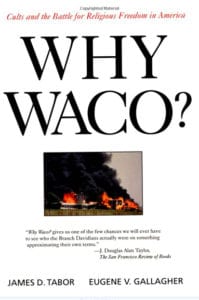
Why Waco: Cults and the Battle for Religious Freedom in America, co-authored with Eugene Gallagher (Berkeley: University of California Press, 1995), paperback edition published in April, 1997. (Kindle link).
Malcom Gladwell, in his featured piece in the New Yorker, “Sacred and Profane: How Not to Negotiate with Believers,” (March 31, 2014) credited Tabor and his colleague Philip Arnold, as singularly pursuing a course of action in the 1993 Waco/David Koresh tragedy that well might have resulted in a peaceful outcome.
Additional Media Coverage: cover review in the Sunday New York Times Book Review; Serialized in Harper’s Magazine, June, 1995; included on New York Times 1995 “Best List” (November 3, 1995 NYTBR) lengthy reviews have appeared in Lingua Franca, Choice, New York Times Book Review, The Washington Post, The Los Angeles Times, The Boston Globe, Kirbus, The New York Review of Books, The Dallas Morning News, The Christian Science Monitor, First Things, Christianity Today and Religious Studies News (AAR/SBL); the book was also reviewed in approximately 38 newspaper chains worldwide.
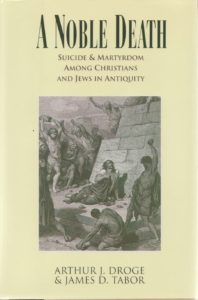 A Noble Death: Suicide and Martyrdom Among Ancient Jews and Christians, co-authored with Arthur Droge (San Francisco and New York: HarperCollins, 1992).
A Noble Death: Suicide and Martyrdom Among Ancient Jews and Christians, co-authored with Arthur Droge (San Francisco and New York: HarperCollins, 1992).
